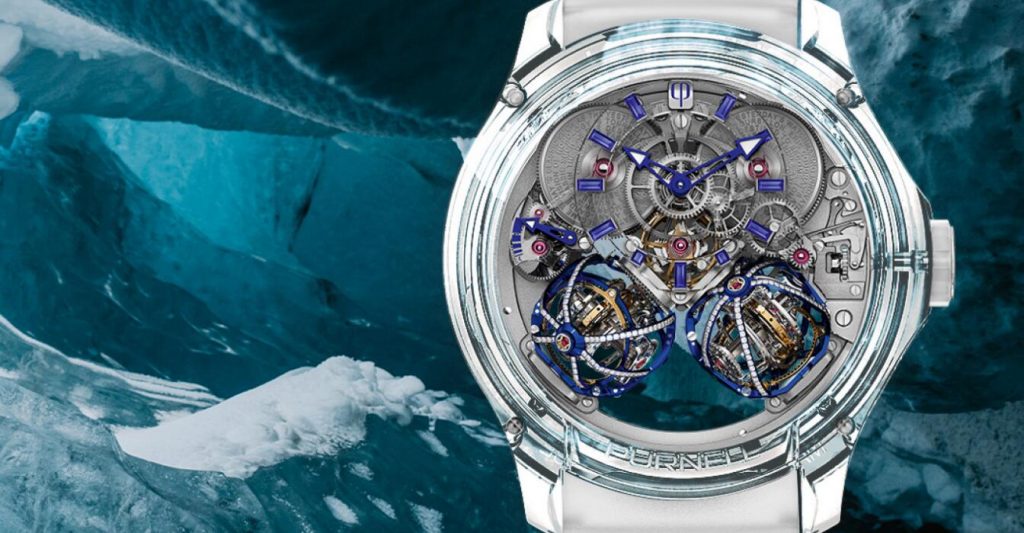Purnell Escape II Carbon and Escape II All Black

The high-speed tourbillon of this tourbillon-only company is based on a surprisingly old idea.
Purnell was originally founded in 2006; founder Jonathan Purnell said that the inspiration for the company came from his grandfather Cecil, a British soldier wounded in World War I. He recovered from an injury in Besançon, France, where he studied watchmaking. As part of his education, Cecil Purnell understood and fascinated the tourbillon, and over time passed his interest on to his grandson. Jonathan Purnell (Jonathan Purnell) has worked in the watch industry for more than 40 years. He has worked for companies including Harry Winston and Vacheron Constantin. When he founded Purnell, he decided that the company would be dedicated to Manufacturing tourbillon watches. The company launched its first watch in 2009 and has been faithful to its original inspiration. In recent years, it has devoted itself to making very gorgeous and very complex timepieces. One of Purnell’s most eye-catching watches is the Escape I Spherion. Escape I was launched in 2017; this is a very high-speed three-axis tourbillon whose frame rotates from the outside to the inside and takes 30, 60, and 8 seconds. In 2019, Purnell launched the Escape II, which has two three-axis Spherion tourbillon systems connected by a differential. It is one of the most dynamic watches I have ever seen.
The tourbillon system is the creativity of watchmaker Eric Coudray. Coudray’s name is not particularly well-known to this day, although his works are indeed so. Recently, he developed the MB&F Thunderdome in cooperation with MB&F and Kari Voutilainen. As you may remember, it is also a three-axis high-speed tourbillon (the frame rotates every 20, 12, and 8 seconds, from the outermost layer to the innermost layer). During his work at Jaeger-LeCoultre, he developed the first tourbillon. Although to this day, his reputation among enthusiasts is not as high as he thought (this may be partly due to his work in terms of price and engineering. Very high-end), but he is an important force in the industry. His company-TEC Ebauches in Warlob-provides complex movements for customers such as Louis Moinet, Manufacture Royale, MB&F, and of course Purnell. , Highly regarded.
Coudray said of his own work: “Most of the things I create are not just watches… it’s not just for performances and all of them. It’s a style of practice.” Of course, if you can easily be mechanically Moved by your creativity, your first reaction to Escape II is often heartfelt and emotional, rather than rational. I cheated on this video a bit, because it is a time-lapse video, but it definitely crosses the vitality of sports.
The latest version of Escape II uses a forged carbon fiber case (there are three versions, distinguished by different colors) and the fourth version, which is made of black DLC grade 5 titanium, is logical and completely black.
No one will be surprised to find that these are quite large watches, although I don’t think you can reasonably expect dual and three-axis tourbillon watches to be very large-these are 48mm x 19mm. The case is designed to make the movements of the two three-axis frames as visible as possible. This includes a cut-out on the bottom edge of the case, in which there is a sapphire window (the side window is actually a part of a crystal, not a separate window), so that even You can actually see the tourbillon without looking directly at the watch.
There are also many windows on the side of the case, and overall, the visual effect is very fascinating-even in the still images, the contrast between the mechanical complexity and the finishes of the various components is very eye-catching.
The mechanical solution to the problem of running a three-axis tourbillon at such high speeds is based on an escapement, which was originally invented by American watchmaker Albert Porter in the mid-1800s. Porter was born in Albany, New York in 1836, and moved to Geneva in 1875. He was responsible for the production of a variety of observatory-class pocket watches, with highly recognizable table bridge layouts, and usually very clever mechanical designs. His escapement uses a fixed escape wheel with its teeth facing inward, and the escape wheel is driven by a running wheel. The first use of this arrangement in a high-speed tourbillon, as far as I know, was Franck Muller‘s five-second tourbillon (however, this is a single-axis tourbillon).
Usually, the tourbillon frame carries the escape wheel, lever and balance wheel, and the pinion of the escape wheel meshes with the teeth of the fixed (non-rotating) fourth wheel. The frame is propelled by the running gear train. When it rotates, the escape wheel rotates against the teeth of the fixed fourth wheel, which in turn transfers energy to the lever and balance wheel.
However, for very high-speed tourbillons, this arrangement is a challenging arrangement due to the amount of inertia involved. For the Spherion system, another arrangement is used in which the escape wheel is fixed-this is Porter Escapement. The teeth of the escape wheel are facing inward, and when the innermost frame rotates, the pallet fork of the lever meshes with the teeth of the escape wheel. The balance wheel locks and unlocks the lever in the usual way, thereby transferring energy to the balance wheel.
The biggest challenge of any tourbillon is that its mechanism is an energy parasite. Usually, in a traditional movement, the fourth wheel directly drives the escape wheel and then transfers energy to the lever and balance wheel. Due to friction (which can be reduced but never completely eliminated) and the escapement itself, due to the sliding friction at the lever tray and the geometry of the lever, energy loss occurs throughout the drive chain. Ensuring that enough energy enters the balance wheel to maintain the best amplitude in the entire power reserve of the watch used to be, and still is, one of the main challenges of the precision watch industry. watches sale uk
In the tourbillon, because the drive train must not only drive the escape wheel, but also the lever and balance wheel, and deal with the inertia of the frame itself, the problem becomes more serious; every time the lever unlocks the escape wheel, the entire device must be Start from the rest position. For this reason, even traditional tourbillons have historically had to be built with very high precision, and the frame has always been as light as possible to reduce the load in operation.
As you can imagine, the problem of multi-axis tourbillons is getting more and more serious, especially if you want to run at high speeds. For this reason, titanium is a commonly used (if you can say “common” for multi-axis tourbillons) material frame, but you still have to keep the structural balance spring thin. In the Spherion system, the gap between the cages is very small-0.1 to 0.2 mm-and the weight of the entire kit and the kaboodle is only 0.79562 grams, which Purnell proudly says is “less than the weight of a standard paper clip.” Each Spherion has a total of eight Incabloc anti-vibration systems-two for each of the three frames, and the other two for the balance itself.
Considering the complexity of the system, the size of the watch is not Brobdignagian at first, but reasonable. As Coudray said, the idea is not only to make mechanically smart things, but also to use ingenuity and machinery to make as many visually dazzling things as possible.
It’s dazzling, Escape II has, and then some. I am free to simply enjoy these watches as an abstraction. Even if you will never be its customer (or, if you are a potential customer, this is not your specific vodka brand), you can still enjoy the fun of this watchmaking industry, and a lot of it, for me, become a watch hobby The pleasure of the reader is seeing the work of people like Eric Coudray evolving over the years-occasionally there is nothing wrong with a little (or a lot) of amazing factors. The only drawback, really, is that I always want to see things like this with my own eyes, and now this has happened. But knowing that the impeccable minimalist watchmaking craftsmanship combined with true technical talent is still vibrant and cool.
Purnell Escape II all black and forged carbon models: case, forged carbon or grade 5 titanium with black DLC coating; both are 48mm x 19mm and water resistant to 30 meters. Movement, caliber CP03, designed by Eric Coudray, three-axis double tourbillon “Spherion”, frame rotating in 30, 16 and 8 seconds; Porter escapement with fixed escape wheel. Frequency, 21,600 vph, 67 jewels, 32-hour power reserve; use suspended mobile cone for power reserve indication. The 6 mainsprings in the 4 barrels run in parallel. Adjust to 12 positions (I assume there are 6 in each Spherion). The total weight of the movement, 15.7 grams.
